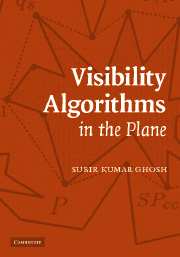6 - Visibility Graph Theory
Published online by Cambridge University Press: 14 August 2009
Summary
Problems and Results
In the previous chapter we discussed how to compute the visibility graph of a polygon P with or without holes. Consider the opposite problem: let G be a given graph. The problem is to determine whether there is a polygon P whose visibility graph is the given graph G. This problem is called the visibility graph recognition problem. The problem of actually drawing one such polygon P is called the visibility graph reconstruction problem. The visibility graph recognition and reconstruction problems are long-standing open problems. So far, only partial results have been achieved. It has been shown by Everett [133] that visibility graph reconstruction is in PSPACE. This is the only upper bound known on the complexity of either problem.
Ghosh [154] presented three necessary conditions in 1986 for recognizing visibility graphs of simple polygons under the assumption that a Hamiltonian cycle of the given graph, which corresponds to the boundary of the simple polygon, is given as input along with the graph. It has been pointed out by Everett and Corneil [133, 135] that these conditions are not sufficient as there are graphs that satisfy the three necessary conditions but they are not visibility graphs of any simple polygon. These counter-examples can be eliminated once the third necessary condition is strengthened.
- Type
- Chapter
- Information
- Visibility Algorithms in the Plane , pp. 171 - 217Publisher: Cambridge University PressPrint publication year: 2007



